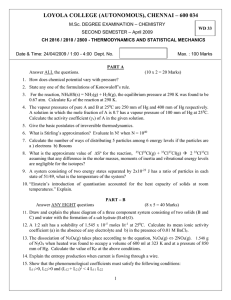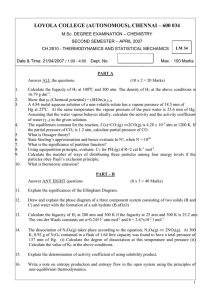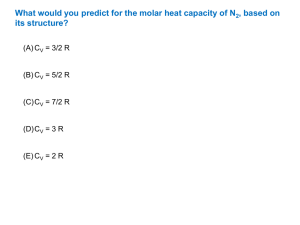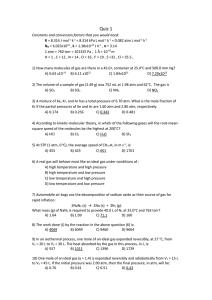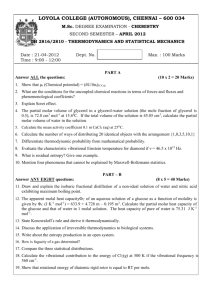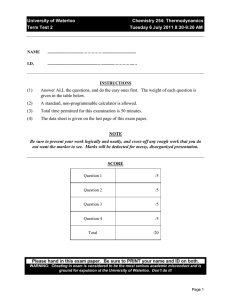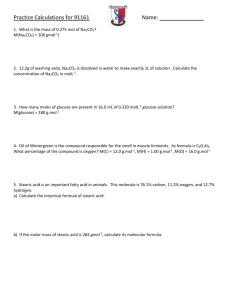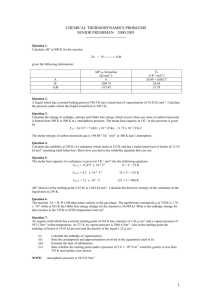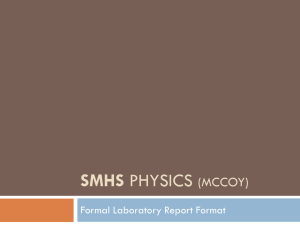LOYOLA COLLEGE (AUTONOMOUS), CHENNAI – 600 034
advertisement
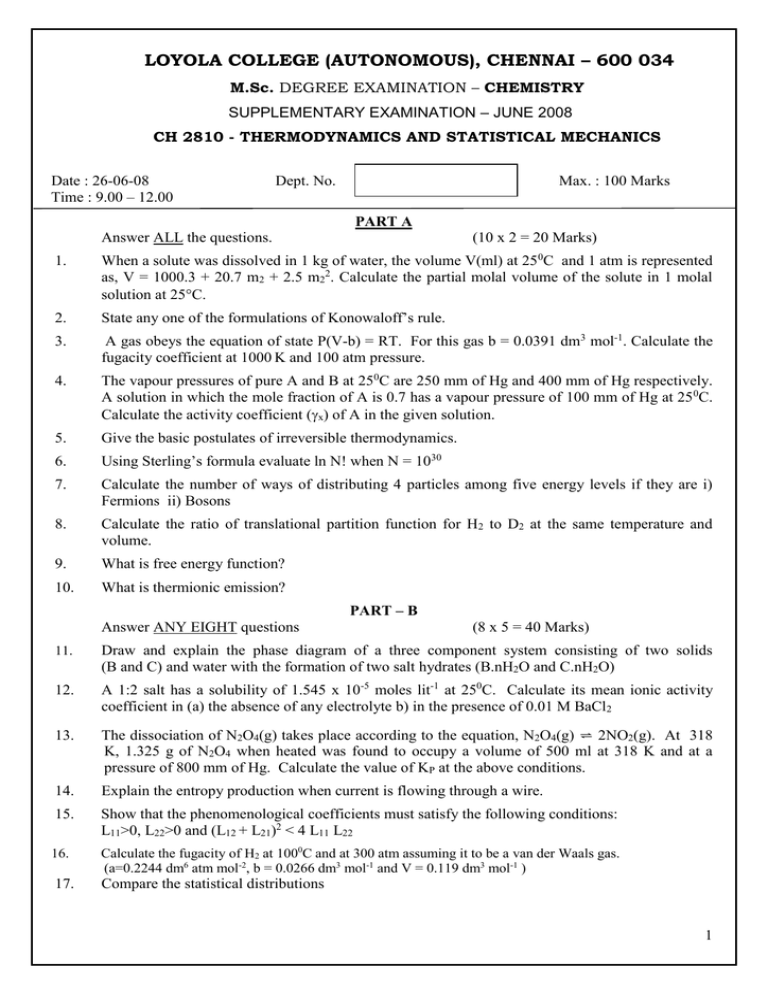
LOYOLA COLLEGE (AUTONOMOUS), CHENNAI – 600 034 M.Sc. DEGREE EXAMINATION – CHEMISTRY SUPPLEMENTARY EXAMINATION – JUNE 2008 CH 2810 - THERMODYNAMICS AND STATISTICAL MECHANICS Date : 26-06-08 Time : 9.00 – 12.00 Dept. No. Max. : 100 Marks PART A Answer ALL the questions. (10 x 2 = 20 Marks) 1. When a solute was dissolved in 1 kg of water, the volume V(ml) at 250C and 1 atm is represented as, V = 1000.3 + 20.7 m2 + 2.5 m22. Calculate the partial molal volume of the solute in 1 molal solution at 25C. 2. State any one of the formulations of Konowaloff’s rule. 3. A gas obeys the equation of state P(V-b) = RT. For this gas b = 0.0391 dm3 mol-1. Calculate the fugacity coefficient at 1000 K and 100 atm pressure. 4. The vapour pressures of pure A and B at 250C are 250 mm of Hg and 400 mm of Hg respectively. A solution in which the mole fraction of A is 0.7 has a vapour pressure of 100 mm of Hg at 25 0C. Calculate the activity coefficient (x) of A in the given solution. 5. Give the basic postulates of irreversible thermodynamics. 6. Using Sterling’s formula evaluate ln N! when N = 1030 7. Calculate the number of ways of distributing 4 particles among five energy levels if they are i) Fermions ii) Bosons 8. Calculate the ratio of translational partition function for H2 to D2 at the same temperature and volume. 9. What is free energy function? 10. What is thermionic emission? PART – B Answer ANY EIGHT questions (8 x 5 = 40 Marks) 11. Draw and explain the phase diagram of a three component system consisting of two solids (B and C) and water with the formation of two salt hydrates (B.nH2O and C.nH2O) 12. A 1:2 salt has a solubility of 1.545 x 10-5 moles lit-1 at 250C. Calculate its mean ionic activity coefficient in (a) the absence of any electrolyte b) in the presence of 0.01 M BaCl2 13. The dissociation of N2O4(g) takes place according to the equation, N2O4(g) ⇌ 2NO2(g). At 318 K, 1.325 g of N2O4 when heated was found to occupy a volume of 500 ml at 318 K and at a pressure of 800 mm of Hg. Calculate the value of KP at the above conditions. 14. Explain the entropy production when current is flowing through a wire. 15. Show that the phenomenological coefficients must satisfy the following conditions: L11>0, L22>0 and (L12 + L21)2 < 4 L11 L22 16. Calculate the fugacity of H2 at 1000C and at 300 atm assuming it to be a van der Waals gas. (a=0.2244 dm6 atm mol-2, b = 0.0266 dm3 mol-1 and V = 0.119 dm3 mol-1 ) 17. Compare the statistical distributions 1 18. For NO(g), the first electronic excited state is two fold degenerate and it is 121 cm -1 above the ground level while the ground state is two fold degenerate. Evaluate the electronic partition function at 300 K. 19. Explain how equilibrium constant of a reaction can be evaluated using free energy functions. 20. Calculate the rotational contribution to entropy for O2(g) at 250C? (I=1.94x10-46 kg m2) 21. Derive an expression for (CV)vib of a diatomic molecule. 22. Explain the application of Fermi-Dirac Statistics to electron gas (metals) PART – C Answer ANY FOUR questions 23. (4 x 10 = 40 Marks) a) How will you determine the mean ionic activity coefficient of HCl by EMF measurements? (5) b) At 1123 K the dissociation pressure of CaCO3(s) is 1.02 atm. At the same temperature when the reaction C(s) + CO2(g) ⇌ 2CO(g) takes place, the equilibrium mixture contains 65 % by volume of CO and 35 % by volume of CO2. If a mixture of CaCO3(s), CaO(s) and C(s) is allowed to come to equilibrium at 1123 K, what is the partial pressure of CO at equilibrium, if the reaction is CaCO3(s) + C(s) CaO(s) + 2CO(g). All reactions take place at a total pressure of 1 atm (5) 24. a) What is Onsager’s reciprocal relationship? (3) b) How is Onsager’s reciprocal relationship verified experimentally by thermoelectric method? (7) 25. For the reaction H2S(g)+3/2 O2(g) H2O(g) + SO2(g), H0298 K = -518.62 kJ mol-1, G0298 K = -495.95 kJ mol-1. Compute the value of KP at 773 K. CP (H2S) (J K-1 mol-1) = 26.722 + 23.87 x 10-3 T, CP (O2) (J K-1 mol-1) = 25.51 + 13.62 x 10-3 T, CP (H2O) (J K-1 mol-1) = 30.21 + 9.93 x 10-3 T and CP (SO2) (J K-1 mol-1) = 25.72 + 57.92 x 10-3 T 26. Explain Debye’s theory of heat capacity of solids and write the expression for C V. Compare the theory with other theories. 27. Explain any two of the following: a) heat capacity of ortho-para hydrogen (5+5) b) Statistical formulation of ARRT c) Bose-Einstein statistics and photon gas d) Significance of Sackur-Tetrode equation 28. Explain the postulates of Bose-Einstein distribution law and hence derive an expression for most probable distribution of particles. . ******************************************* 2
